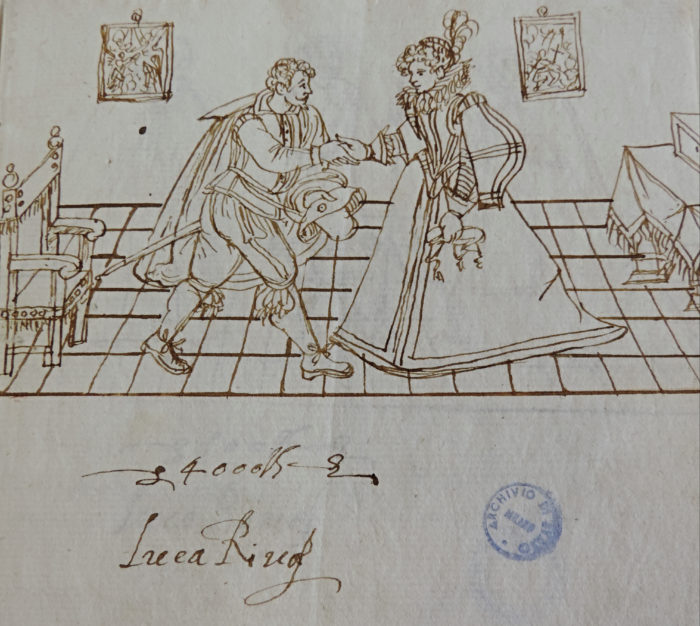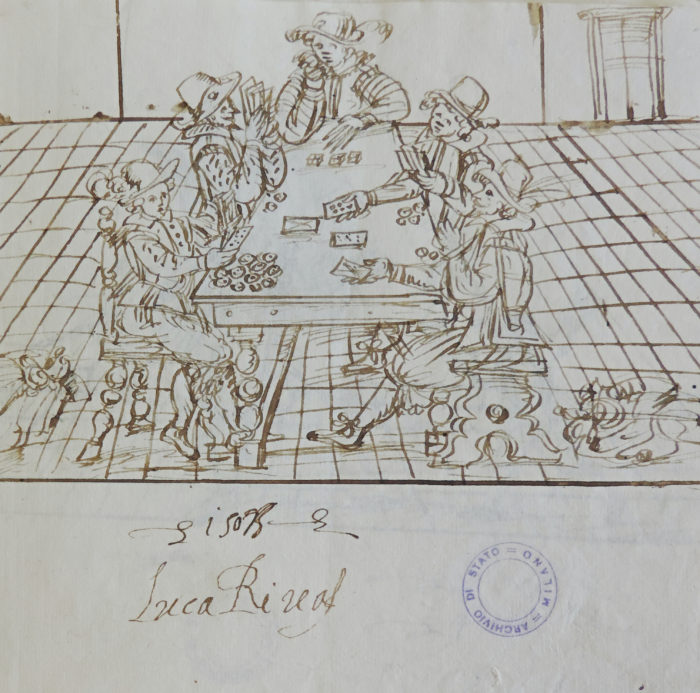Luca Riva (c. 1591–1624)
Click on the images to find out more
Luca Riva was born in Milan around 1591. Little biographical detail exists on his life and the only proof of his artistic career is the drawings he made on 9 September 1624 to illustrate his last will. Instead of taking the form of a written testament, Riva drafted his will in the form of ten brown-ink drawings bound together in a small volume. Conserved in the Milan State Archive, this document is the only extant testament known to have been made exclusively of visual elements and represents a crucial resource with which to investigate interconnections between art and disability in the early modern period.
Luca Riva was married to a woman named Laura Farina. The couple had no children but three nephews. The eldest, Giulio Riva, liked gambling. The youngest, Carlo and a niece–whose name is still untraceable–were the children of Felice Riva, Luca’s brother, who had been found guilty of murder. The Riva family lived in a house in the central parish of San Vito in Pasquirolo. Located in the area to the east of Milan cathedral, the parish accommodated affluent households engaged in the textile industry, especially in the spinning and weaving sectors. That Luca was a member of one of these rich families can be inferred from the extent of his bequest, which exceeded 14750 lire imperiali. The sum doubled the annual salary of a merchant operating between Milan and Antwerp and was sufficient for real estate investments in the city’s residential parishes
Riva studied painting and drawing in the teaching facility owned by the Procaccini family in Milan. Camillo (1561-1629), Carlo Antonio (1571-1630) and Giulio Cesare Procaccini (1574-1625) were the sons of the Bolognese painter Ercole Procaccini the Elder (1520-1595). Born in Emilia, they moved to Milan in the autumn of 1587, establishing a painting business that for four decades played a decisive role in the development of Lombard art. Riva was a student of Camillo Procaccini, the eldest brother, regarded by the local connoisseur Girolamo Borsieri as the “master of modern draughtsmen, the one who even in the most insignificant sketch followed the rules of movement and perspective”.
The testament illustrates scenes of people and institutions to whom he wished to leave money, including his wife, nieces and nephews and various bequests to religious institutions, orphanages and hospitals. Often witty and theatrical in style, the drawings include a linear perspective grid and are characterised by disproportionately elongated hands, a visual device possibly adopted to emphasise the importance of gestures. The drawings are accompanied by a twenty-seven-page document signed by notary Pietro Antonio Calchi and physician Baldassare Capra. The account chronicles events that occurred on 9 September 1624 providing information on Riva’s personal circumstances and a detailed explanation for each of his drawings. It clarifies that the drawings were shown to judge Giambattista Visconti and explained by Riva himself in the language of signs. Assisted by interpreters Giulio Cesano and Bartolomeo Cavallozzo, Visconti interpreted Riva’s instructions, and once the correct meaning for each drawing had been verified, he authorised the painter to validate them with his signature.
Riva’s testament is a proud statement of his artistic skills and love for his profession. The document testifies to the progressive approach adopted by the State of Milan towards deaf people. The drawings were indeed regarded as equivalent to handwriting, a juridical interpretation accepted by Italian law only in the second half of the twentieth century.
Bibliography
Lo Conte, Angelo. ‘A Visual Testament by Luca Riva, a Deaf and Mute Pupil of the Procaccini’. Renaissance Studies, 36 (2), 2022, 222–251. https://onlinelibrary.wiley.com/doi/epdf/10.1111/rest.12730
Locker, Jesse. ‘Luca Riva: a deaf painter in Spanish Milan’. Source: Notes in the history of Art, vol. 41 (3), 186-196.
Lo Conte, Angelo. The Procaccini and the Business of Painting in Early Modern Milan. New York, 2021.
Chiappa, Franca and Angelo Piazza, Il testamento di Luca Riva. Milan, 1970.
Bendiscioli, Mario. ‘Vita sociale e culturale’. In Storia di Milano, Vol. X. L’età della Riforma cattolica, 1559-1630, Mario Bendiscioli (ed.), Milan, 1957.


